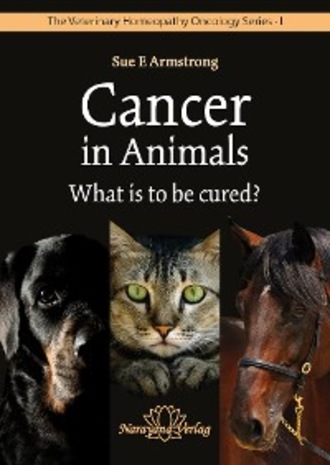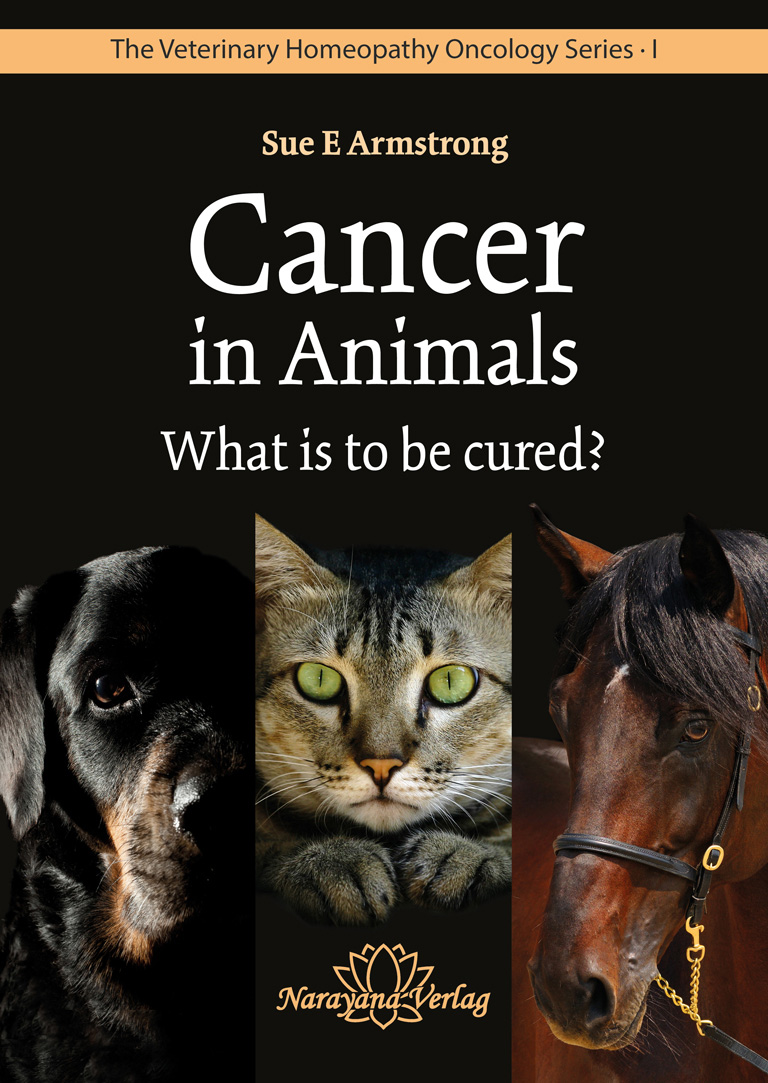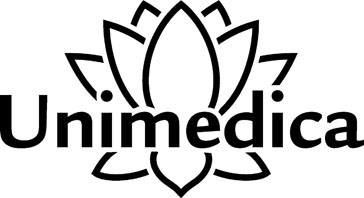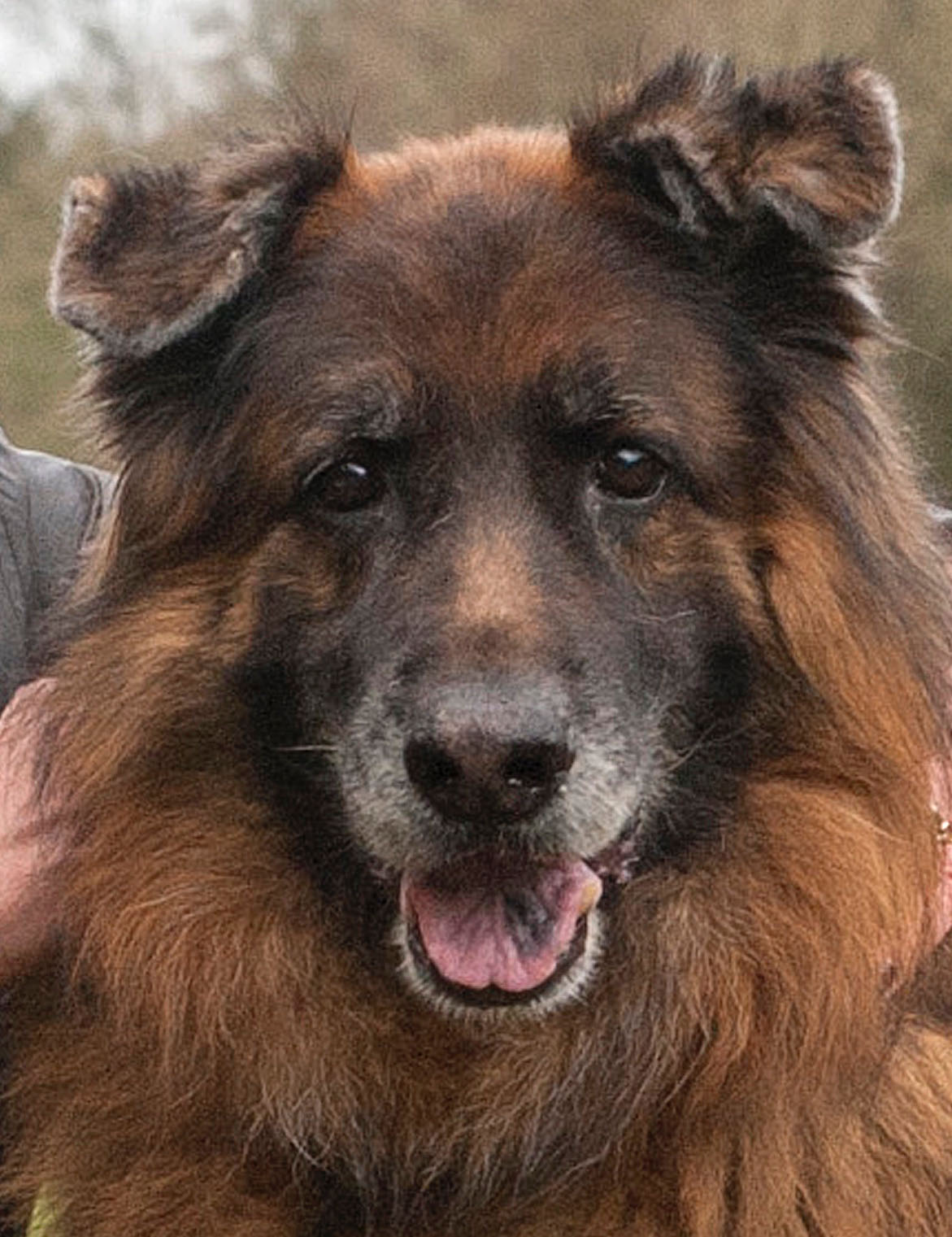
Полная версия
Cancer in Animals - What is to be cured?


The Veterinary Homeopathy Oncology Series
Sue E Armstrong
Cancer
in Animals
What is to be cured?
Vol. 1

IMPRINT
Sue E Armstrong
Cancer in Animals
What is to be cured?
The Veterinary Homeopathy Oncology Series I
First Edition 2016
E-Book ISBN: 978-3-95582-131-9
© Narayana Verlag 2016
Cover layout: Narayana Verlag
Cover illustrations: Tatiana Makotra/shutterstock.com, Maciej Bledowski/shutterstock.com, pirita/shutterstock.com
Narayana Verlag GmbH, Blumenplatz 2, 79400 Kandern, Germany Phone +49 7626 9749700; info@narayana-verlag.com; www.narayana-verlag.com
All rights reserved. Without the written permission of the publisher, no part of this book may be reproduced, duplicated, photocopied, translated or stored in any form by any mechanical, electronic or photographic process, with the exception of short passages for book reviews.
In so far as registered trademarks, trade names and common names are used, the usual protections apply (even if these are not marked as such).
The recommendations in this book have been compiled and checked to the best know-ledge of the author and publisher. There is nevertheless no guarantee provided. Neither the author nor the publisher shall be held liable for possible detriment or damage resulting from the instructions in the book.
CONTENTS
Imprint
Dedication
Acknowledgements
Foreword
Introduction
SECTION ONE: Through the Conventional Lens (The chicken and the egg)
Chapter 1: The conventional (Molecular Level) Understanding of neoplasia – Cancer as a Genetic Disease
Defining the words we use for cancer
The aetiology of neoplasia
The genes involved in neoplasia
Hanahan and Weinberg hallmarks of cancer
Stem cell theory of cancer
Cancer prevention and screening
Cancer diagnostics
Conventional therapeutics
Where homeopathy meets the conventional paradigm
Bibliography and references
Chapter 2: The Role of Inflammation in Cancer
Inflammation and the cancer connection
Plant remedies for cancer and inflammation
The microbiome, inflammation and the connection with the bowel nosodes in cancer management
Mineral remedies used in cancer and inflammation
Other important remedies involved in the cancer and inflammation connection
Final words
Bibliography and references
Chapter 3: Oxygen and its Role in Cancer
Bibliography and references
SECTION TWO: The Homeopathic Perspective (The dynamic nature of disease – before the chicken)
Chapter 4: The Homeopathic Understanding of Cancer from Hahnemann to the 21st Century
Samuel Hahnemann (1755-1843)
James Tyler Kent (1849-1916)
Arthur Hill Grimmer (1874-1967)
James Compton Burnett (1840-1901)
Robert Thomas Cooper (1844-1903)
RM Le Hunt Cooper
Donald Foubister (1902-1988)
William Lees Templeton (1898-1978)
Dr AU Ramakrishnan (1942-)
Dr Prasanta Banerji (born 1933)
Bibliography and references
Chapter 5: A Homeopathic Approach to Cancer
1. High-risk patients – no cancer presenting
2. Cases with a pre-cancerous condition
3. Cases with confirmed primary tumour (no conventional intervention)
4. Primary tumour – surgical cases
5. Primary tumour – animal on adjunct therapy
6. Cases with Stage IV cancer – advanced metastatic disease
Bibliography and references
Chapter 6: Organ Remedies, Drainage Theory and Tissue Salts their use in the Management of Cancer Cases
Primary organ disease and organ remedies (organopathy)
Drainage
Tissue salts (biochemic therapeutics)
Bibliography and references
Chapter 7: Treating the Secondary Features of Cancer
1. Gastrointestinal
2. Haematological disorders
3. Endocrinological changes
4. Cutaneous disorders
5. Renal disorders
6. Neurological and musculoskeletal disorders
7. Miscellaneous disorders
Bibliography and references
Chapter 8: Carcinosinum and Scirrhinum
Carcinosinum: know the nosode
Scirrhinum
Bibliography and references:
Chapter 9: The Evidence base for the use of Homeopathy in Cancer
Case studies
The mixed modality nature of most veterinary cancer cases
Three cases of multiple primary tumours in dogs – an integrative medicine approach
In vitro studies showing the action of homeopathic medicines on cancer cells
References and list of published papers on different aspects of homeopathy and cancer in both animals and humans
Chapter 10: A Materia Medica for Cancer
Location of the cancer
Bibliography and references
APPENDIX
A Brief Introduction to Homeopathy for Beginners
Glossary of Homeopathic Terms
Names and Abbreviations of Homeopathic Remedies
Index of Symptoms
Index of Illness/Conditions
Index of Remedies
About the Author
DEDICATION
KEI

Photograph by Ruth Downing
21/06/2003 - 26/11/2014
Kei completed his life during the final stages of the writing of this book. He was my constant companion for eleven and a half years and taught me endless lessons throughout our time shared together – but none so profound as when he presented with cardiac haemangiosarcoma and rapidly progressing lung metastases. He left within 5 days of revealing his first clinical symptoms. No homeopathy, chemotherapy, radiotherapy, targeted therapy or any other therapy was going to save him; this was his time.
ACKNOWLEDGEMENTS
To my husband Rick, who thankfully has the same work ethic as I do, your love, support and patience has meant everything to me. My constant companion for over 11 years, Kei, taught me untold amounts about so many aspects of life, death, relationship and love, and until his leaving he made it imperative for me to walk in the fresh air and connect with nature at least a little every day. My sons, who grew up despite me to make me immensely proud, encouraged me at every step and provided me with plenty of their opinions during the many healthy discussions around the dining table at home, have helped me to develop my thoughts around the issues raised in this book. My heartfelt thanks and love go to my parents who are as much now my best friends as they are my source. They have provided me with reason, purpose, encouragement, and of course the genes that help to make me who I am and do the things that I do in my life.
Homeopathy would not have entered my life were it not for John Saxton, a business partner, colleague and friend for many years. I have learnt much from working and teaching alongside him and am so very grateful to him for pointing me in the direction that I have now taken. There are so many homeopaths around the world that have shaped and contributed to my practice and way of thinking and I am grateful to each and every one of them. There is one who will never be surpassed and that is of course Samuel Hahnemann who was a visionary genius; his legacy has held me on my course at times when it would have been so much easier to forget all about homeopathy and pretend it does not exist. It is the students and the trailblazers from around the world, who are so hungry to learn, who have given me immense joy and inspiration, notably Julie Ann Lee (Canada), Yumi Koseki and Tsubomi Suzuki (Japan), Jaana Kolehmainan (Finland), Morten Riis (Denmark), Shelley Epstein, and the many wonderful members of the AVH (USA). There are so many others, I hope they know who they are, as well, of course, as friends and colleagues in the homeopathic community in the UK, especially my dear friend and colleague Wendy McGrandles who doesn’t let me get away with anything!
To Isobel, Doug, Mary and Conrad who have helped keep Balanced Being afloat in difficult times, when I have stubbornly held on to my principles and refused to become a peddler of drugs, foods and treatments that I do not believe to be in the best interests of my patients (decisions that had made sustaining a viable veterinary business, in this era, difficult to say the least), I cannot thank you enough. The same goes to my loyal staff who have had to deal with my endless deadlines and seeming diversions from simply being a clinician; I think they too see the bigger picture of how important it is to share the knowledge and experience that we have all had at the practice, working in the way that we do. A special mention must go to Vivien Swift, one of the most courageous women I have ever met and a veterinary homeopath in her own right, who has done many hours of researching for this book as well as for many of my other talks and ventures.
My thanks go to my publishers Narayana Verlag for their support, integrity and professionalism. This book has been a long time coming and my visit to their publishing house in 2013, spending that short time with members of the family and business, was such a great inspiration and encouragement.
There are no greater teachers for any veterinary surgeon than the many clients and animals that come to us for help and treatment; every one of them has played their part in developing my understanding of health and disease. Finally, I would like to acknowledge the millions of animals whose lives have been taken in the name of cancer research over many decades. Human beings have so very much to answer for.
FOREWORD
This is the first in a series of books on the homeopathic and integrative approach to veterinary cancer management in animals. Other books in the series will cover nutrition and supplements in cancer management, canine neoplasia, feline neoplasia and equine neoplasia. The species-specific books will cover the major cancer types for each species and will include example case studies throughout.
I have been developing my ideas and current understanding for over 30 years in clinical veterinary practice, treating mostly dogs, cats, horses and also humans as an RSHom. Of all the chronic case manifestations that I have had to deal with on a daily basis, cancer is the one that I have been drawn to because it challenges us all as practitioners on so many levels. Cancer exposes our inadequacies, fears and falsehoods perhaps better than any other disease process and it can be so unforgiving when it does it. No other disease process has had as much money poured into it for research over the decades as the collective of cancer. The history of how this money has been allocated and what the human race has done with the findings of the research has provided us with a beautiful mirror on human nature, greed and politics that has changed little as we evolve.
My initial intention when starting these books was to provide a comprehensive body of work to support the work of veterinary homeopaths. However, the concept of the books has evolved as I have talked to conventional veterinary oncologists and to clients who have experienced the cancer process in their own animals. I hope that the series will provide a source of information to help everyone involved in cancer in animals, or indeed in humans, to see things from a different perspective, and to piece together the different ideologies into a more unified whole.
My nature includes a deep aversion to conflict, which of course has ended up being the challenge of my life, as our deepest fear nearly always does. It has been the saddest aspect of my life’s work that homeopathy has brought me nothing but conflict, most notably in the aggressive attitude towards it held by so many members of my own profession. None of us has all the answers to treating the diseases that afflict humans and other animals, nor do any of us fully understand the purpose of disease and what is truly to be cured. Homeopathy is not a belief system, it is a science, and we ignore it at our peril.
INTRODUCTION
Cancer is not a new disease; it has been a part of the story of humans and other animals from the beginning of cellular life on earth. A fossilised rib excavated from a shallow cave at Krapina, Croatia, came from a Neanderthal living 120,000 years ago and was found to have the same bone tumour type that is commonly found in humans and animals today. Bone is the most common tissue remaining from our ancestors and one of our few tangible connections with the dead. Other examples of cancer, in other organs and tissues, have been found in Egypt in the mummified remains of humans living between 1000 and 4000 years ago, confirming that we have a long history of living and dying with cancer.
Cancer is nearly always viewed as the enemy, a terrible disease that we have to eradicate and fight. Every cancer charity, government and organisation talks in this way, making us deeply fear not only the disease but the very word cancer. I have patients who cannot even bear to see the word written, and resort to such requests as “Please do not use the ‘c’ word”. There is perhaps a greater depth to the story of cancer than is obvious at first sight: cancer may well be inevitable for at least a percentage of us and our animals if we do not die prematurely from other causes such as accidents, epidemic diseases or poisoning. However, only a percentage will inevitably succumb to cancer; other causes of age-related death such as non-neoplastic major organ failure will be the ending for others. Throughout time the volume and nature of the threats that can lead to premature death have changed. As we both identify the threats and learn to deal with each of them, minimising their impact on the health of humans and animals, we are still left with the inescapable birth, life and death scenario of each individual and the natural processes of ageing and dying.
Lesen Sie weiter in der vollständigen Ausgabe!
Lesen Sie weiter in der vollständigen Ausgabe!
Lesen Sie weiter in der vollständigen Ausgabe!
Lesen Sie weiter in der vollständigen Ausgabe!
Lesen Sie weiter in der vollständigen Ausgabe!
Lesen Sie weiter in der vollständigen Ausgabe!
Lesen Sie weiter in der vollständigen Ausgabe!
Lesen Sie weiter in der vollständigen Ausgabe!
Lesen Sie weiter in der vollständigen Ausgabe!
Lesen Sie weiter in der vollständigen Ausgabe!
Lesen Sie weiter in der vollständigen Ausgabe!
Lesen Sie weiter in der vollständigen Ausgabe!
Lesen Sie weiter in der vollständigen Ausgabe!
Lesen Sie weiter in der vollständigen Ausgabe!
Lesen Sie weiter in der vollständigen Ausgabe!
Lesen Sie weiter in der vollständigen Ausgabe!
Lesen Sie weiter in der vollständigen Ausgabe!
Lesen Sie weiter in der vollständigen Ausgabe!
Lesen Sie weiter in der vollständigen Ausgabe!
Lesen Sie weiter in der vollständigen Ausgabe!



